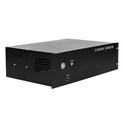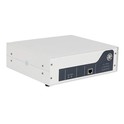As a supplier of 4000w ultrasonic generators, I often get asked if these powerful devices can be used in the food industry. Well, let me tell you, the answer is a resounding yes! In this blog post, I'll explain how a 4000w ultrasonic generator can be a game - changer in the food industry, and I'll also give you some insights into its applications and benefits.
How Ultrasonic Technology Works
Before we dive into the food - industry applications, let's quickly go over how ultrasonic technology works. Ultrasonic waves are sound waves with frequencies higher than the upper audible limit of human hearing, usually above 20 kHz. When an ultrasonic generator like our 4000w model is used, it produces these high - frequency waves, which then create a series of compressions and rarefactions in the medium (like a liquid or a semi - solid).
This process results in a phenomenon called cavitation. Cavitation is the formation, growth, and sudden collapse of tiny bubbles in the liquid. When these bubbles collapse, they release a huge amount of energy in the form of shockwaves. These shockwaves can be used for a variety of purposes, and that's where the magic happens in the food industry.
Applications in the Food Industry
Emulsification
One of the key applications of a 4000w ultrasonic generator in the food industry is emulsification. Emulsions are mixtures of two immiscible liquids, like oil and water. In the food business, you see emulsions all the time - think mayonnaise, salad dressings, and milkshakes.
The high - energy shockwaves from the ultrasonic cavitation break down the larger droplets of one liquid into smaller ones and disperse them evenly throughout the other liquid. This creates a stable emulsion with a more consistent texture. With a 4000w ultrasonic generator, you can achieve a very fine and stable emulsion in a relatively short time compared to traditional methods. For example, in the production of mayonnaise, the ultrasonic emulsification process can lead to a creamier and more homogenous product, which consumers love.
Extraction
Another important application is extraction. Many valuable components in food materials, such as flavors, colors, and bioactive compounds, are trapped within the cells of plants or other food sources. The ultrasonic waves can break open these cells, allowing for the efficient extraction of these components.
A 4000w ultrasonic generator can generate enough power to penetrate the cell walls effectively. In the extraction of essential oils from herbs or the extraction of antioxidants from fruits, ultrasonic extraction can be much faster and more efficient than conventional methods like solvent extraction. It also often requires less solvent, which is not only more environmentally friendly but also reduces production costs.
Homogenization
Homogenization is crucial in the food industry to ensure a uniform distribution of particles in a liquid or semi - liquid product. Dairy products, for example, need to be homogenized to prevent the separation of cream from milk.
The 4000w ultrasonic generator can be used to break down larger particles into smaller ones and distribute them evenly throughout the product. This results in a smoother and more consistent texture. In the production of yogurt, ultrasonic homogenization can improve the mouthfeel and prevent the formation of lumps, making the product more appealing to consumers.
Decontamination
Food safety is a top priority in the food industry. A 4000w ultrasonic generator can also play a role in decontamination. The shockwaves from cavitation can damage the cell membranes of microorganisms like bacteria and fungi, leading to their inactivation.
This non - thermal method of decontamination is especially useful for heat - sensitive food products. For example, in the processing of fresh fruit juices, ultrasonic decontamination can reduce the microbial load without affecting the flavor and nutritional value of the juice as much as heat - based pasteurization methods.
Advantages of Using a 4000w Ultrasonic Generator
Efficiency
As I mentioned earlier, a 4000w ultrasonic generator can perform tasks like emulsification, extraction, and homogenization much faster than traditional methods. This means higher production rates and lower labor costs. You can get more products out in less time, which is a huge advantage in a competitive market.
Quality
The quality of the food products produced with the help of a 4000w ultrasonic generator is often superior. The products have a more consistent texture, better flavor, and higher nutritional value. For example, in the case of emulsions, the ultrasonic - generated emulsions are more stable and have a longer shelf - life.
Environment - friendliness
Ultrasonic processing generally requires less energy and fewer chemicals compared to traditional methods. In extraction, it can reduce the use of solvents, and in decontamination, it can replace some heat - based processes that consume a lot of energy. This makes it a more sustainable option for food manufacturers.
Other Power Options
If a 4000w ultrasonic generator doesn't quite fit your needs, we also offer other power options. For smaller - scale operations or applications that require less power, we have the 500W Ultrasonic Generator. It's a great choice for research labs or small - batch food production.
If you need even more power, our 6000W Ultrasonic Generator can handle large - scale industrial production. And for mid - range requirements, the 2000W Ultrasonic Generator is a solid option.
Conclusion
In conclusion, a 4000w ultrasonic generator has a wide range of applications and numerous advantages in the food industry. Whether you're looking to improve the quality of your emulsions, extract valuable components more efficiently, homogenize your products, or ensure food safety, this powerful device can be a great addition to your production line.
If you're in the food industry and interested in exploring how a 4000w ultrasonic generator can benefit your business, don't hesitate to reach out. We're here to help you find the right solution for your specific needs. Contact us to start a conversation about your procurement requirements, and let's see how we can work together to take your food production to the next level.


References
- Mason, T. J., & Lorimer, J. P. (2002). Applied sonochemistry: uses of power ultrasound in chemistry and processing. Wiley.
- Povey, M. J. W. (1997). Ultrasonics in food processing. Woodhead Publishing.





